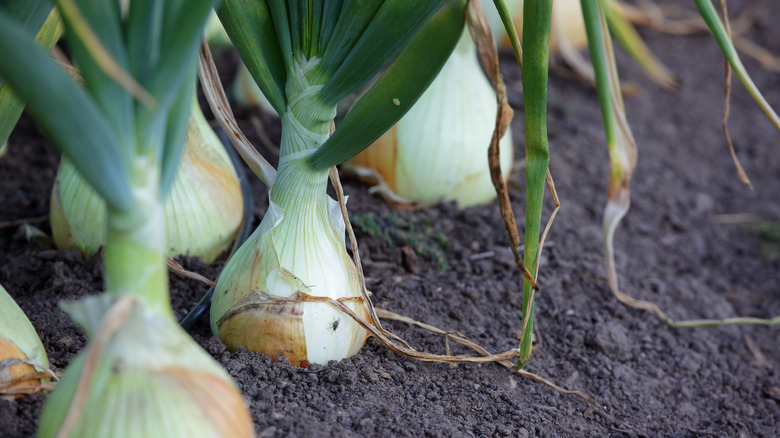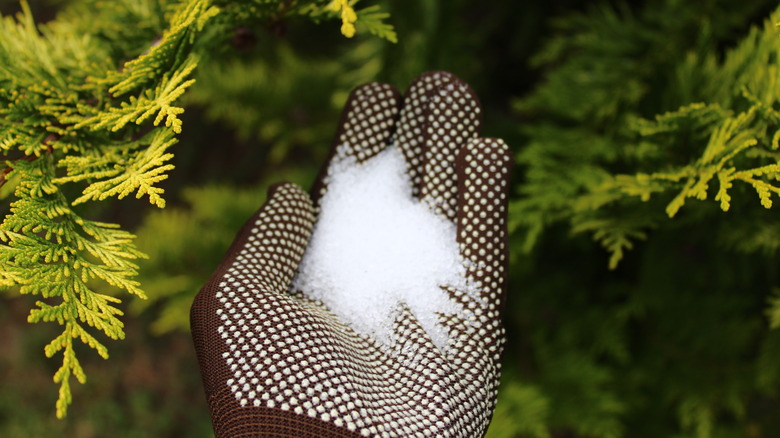The Secret Ingredient That'll Do Wonders For Your Onion Plants
Onions, like many plants in your garden, can run into a variety of growth hiccups that make gardeners scratch their heads. You might notice those once-lush green onion leaves turning yellow, or worse, the whole plant looking a bit stunted and not forming those bulbs you were hoping for. These common issues indicate nutrient deficiencies, especially in magnesium and sulfur. Sometimes, it's not just about what's missing in the soil; factors like pH levels, poor drainage, or planting too close together can also throw a wrench into the onion-growing plans. Nevertheless, there is one common ingredient you likely already have stashed on a shelf in your linen closet that can address some of these issues: Epsom salt.
Epsom salt — the unsung hero for ridding your garden of developmental issues for your precious onions. A little sprinkle of Epsom salt plays a crucial role in addressing nutrient deficiencies in onion plants. Magnesium boosts chlorophyll production, which is crucial to facilitate photosynthesis, enhancing the green color of onion leaves. Simultaneously, sulfur supports overall plant growth, aiding in the development of robust bulbs. The application of Epsom salt provides a targeted nutrient boost specifically tailored to the needs of onions, helping them overcome growth challenges and flourish in the garden. If you observe lackluster growth in your onions, a measured application of Epsom salt can contribute to their overall health and productivity. This inexpensive, all-natural approach ensures a balanced and professional nutrient supplementation, fostering optimal conditions for successful onion cultivation.
When and how to apply Epsom salt
Epsom salt, a crystalline compound of magnesium and sulfate, can be beneficial for onion plants when applied judiciously in the garden. An optimal time to apply Epsom salt is during the early stages of onion growth, specifically at the time of planting or shortly after that. This allows the plants to absorb the magnesium and sulfur components, aiding their overall development. Signs that onion plants may benefit from Epsom salt include yellowing leaves, which could indicate deficiencies in magnesium, calcium, or phosphorus. Magnesium is a crucial component in chlorophyll production, and its absence can lead to poor photosynthesis, resulting in yellow foliage. Additionally, if the soil is deficient in sulfur, onion plants may exhibit stunted growth and reduced bulb formation. Epsom salt provides a quick and accessible source of both magnesium and sulfur.
To apply Epsom salt to onion plants, dissolve it in water according to package instructions and then use it to water the plants. A recommended ratio is around two tablespoons of Epsom salt per gallon of water, applied about once per month. Alternatively, you can work this secret ingredient directly into the soil. Mix Epsom salt into the soil at a rate of approximately one cup per 100 square feet or follow package instructions. Thoroughly incorporate to a depth of a few inches. Water the area well to aid nutrient absorption. This method allows plants, including onions, to access the essential magnesium and sulfur, promoting robust growth.
Cautions for using Epsom salt
While Epsom salt can be a valuable supplement in raising healthy plants in your garden, it's imperative to exercise caution in its application. One primary concern is overuse, as excessive amounts of magnesium sulfate can alter the soil's pH, potentially leading to nutrient imbalances. This imbalance may negatively impact plant health and hinder the absorption of other essential nutrients. Therefore, it is crucial to adhere to recommended application rates and avoid the temptation to use Epsom salt indiscriminately. Another cautionary aspect is the potential environmental impact. Runoff from Epsom salt-treated areas can contribute to nutrient pollution in water bodies, affecting aquatic ecosystems. To mitigate this risk, it's advisable to apply Epsom salt sparingly and consider alternatives when possible.
Determining the necessity of Epsom salt or any soil amendment is best achieved through a soil test. Conducting a soil test provides valuable insights into the existing nutrient levels, helping gardeners make informed decisions about whether magnesium or sulfur supplementation is required. If the soil already contains sufficient levels of these elements, adding Epsom salt may be unnecessary and could lead to nutrient imbalances. Furthermore, a soil test assists in identifying specific deficiencies and allows for targeted amendments. This tailored approach promotes efficient resource utilization, preventing unnecessary costs and potential environmental harm. The benefits of using a soil test before applying any soil additives (including Epsom salt) are that it promotes precision, sustainability, and the overall health of the garden ecosystem.


